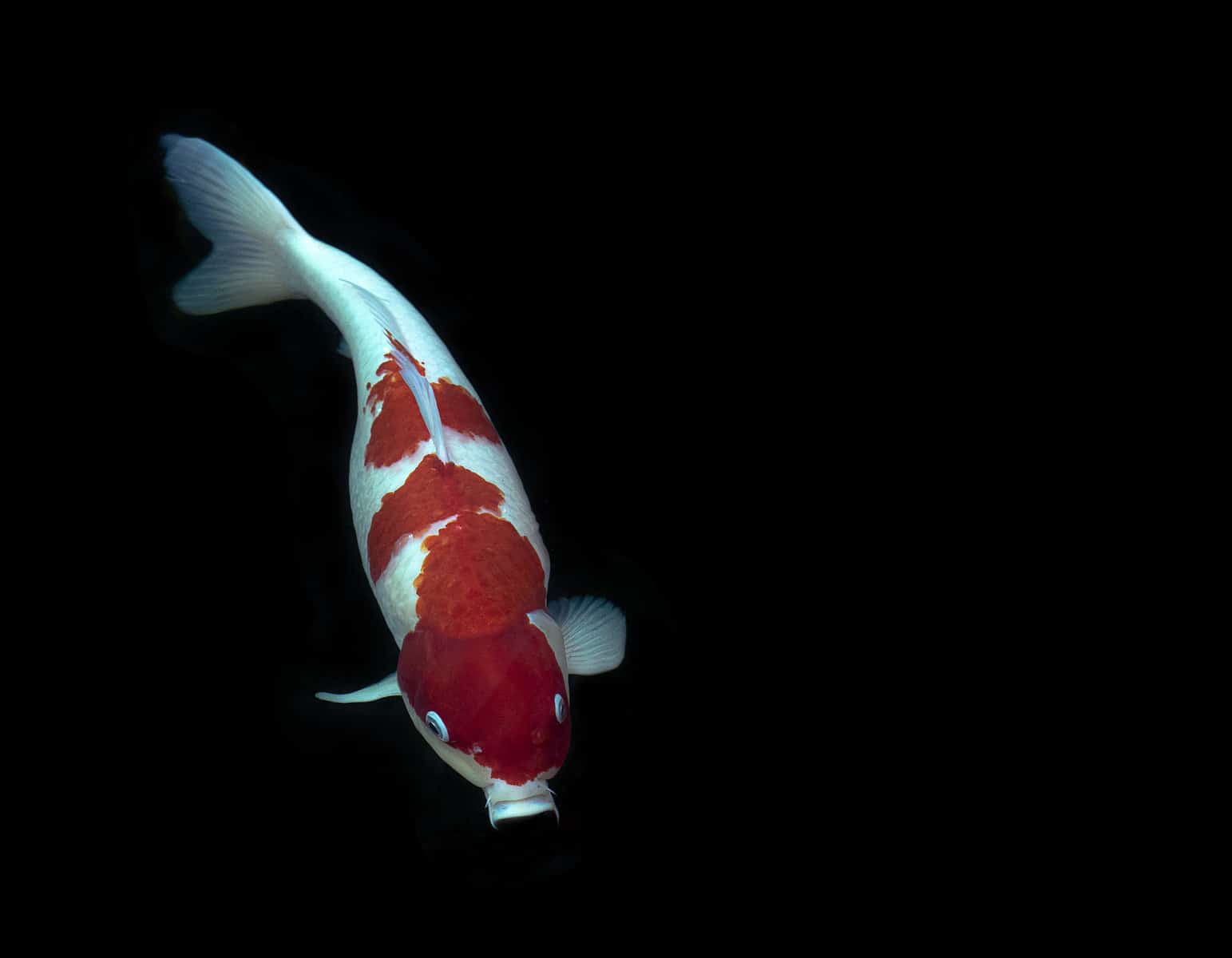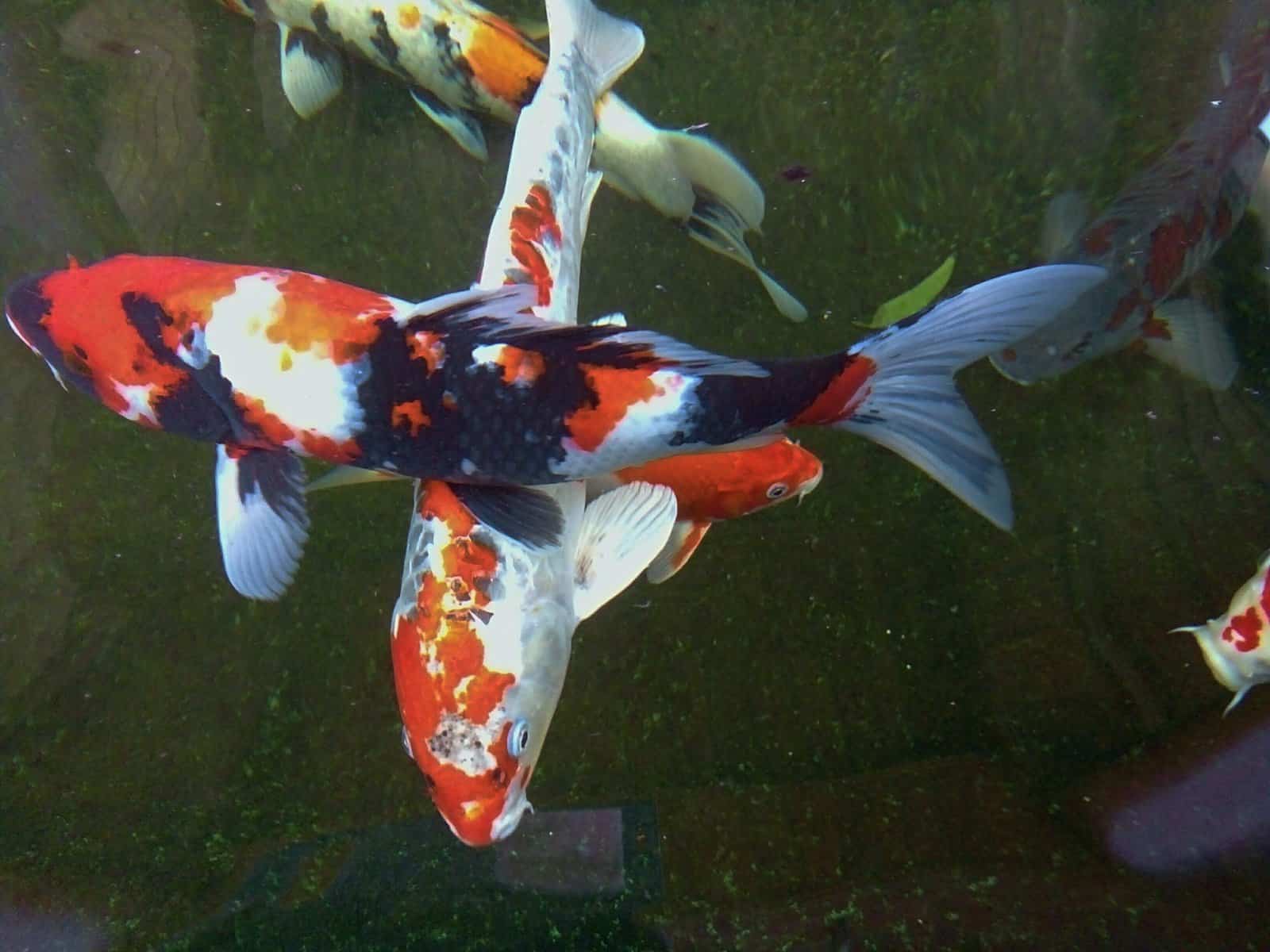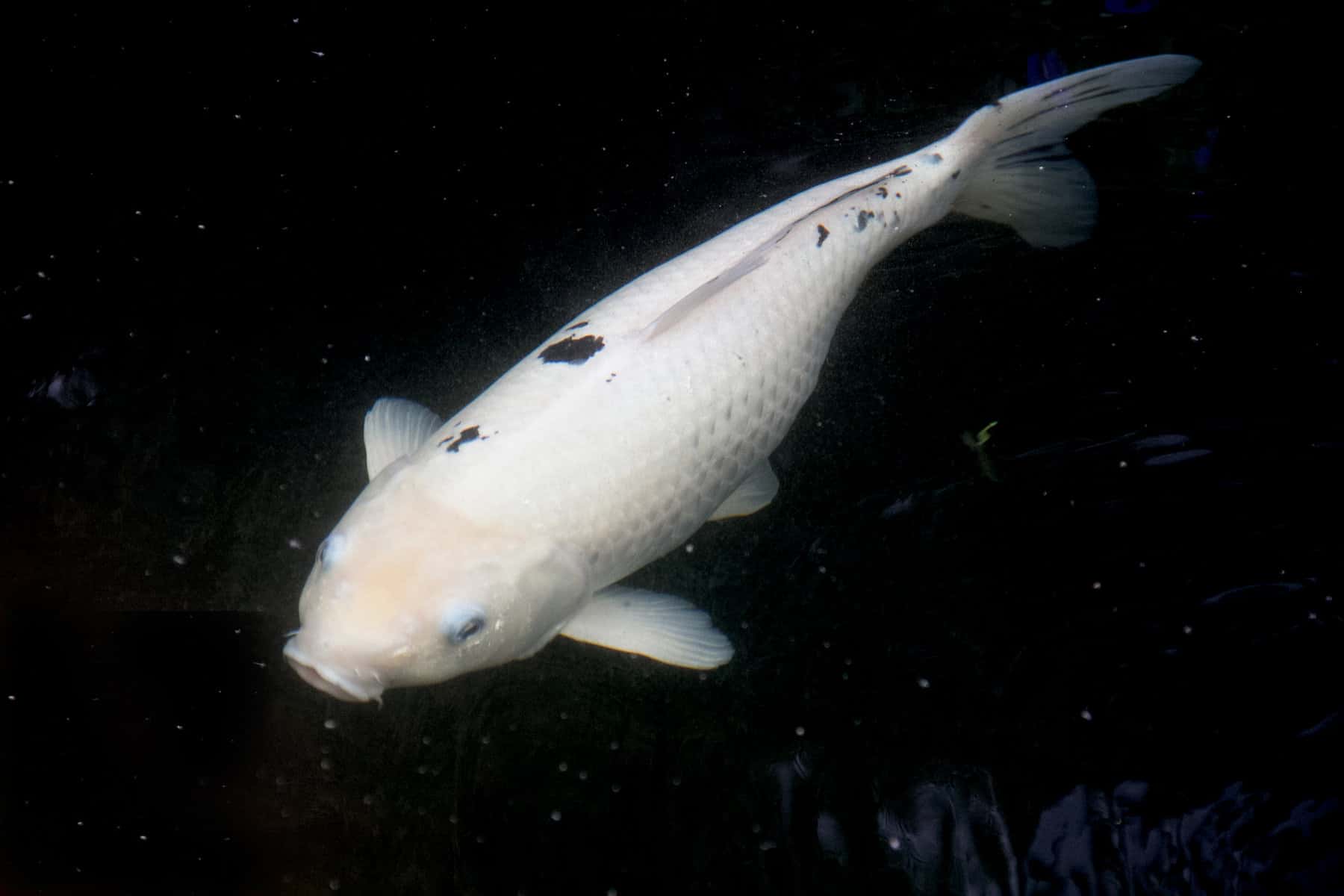[ad_1]
The art of keeping and breeding koi fish is a century-old tradition that has resulted in some of the most beautiful and expensive fish in the aquarium hobby.
As a result, there are over 100 different types of koi fish that each have their own patterns and stories of origination.
Keep reading to find out everything you need to know about the history of koi fish, how to take care of koi fish, and the types of koi that you are most likely to find available at your local fish stores!
The History of Koi Fish
Though Japanese koi fish might seem like an ancient species, these beautiful fish only started to be developed during the 1800’s. In order to understand how we ended up with so many variations today, we need to go back several centuries.
During the Heian period (794-1185) in Japan, it is known that the progenitors of koi fish were already being kept by members of the upper class and nobles; these fish were actually wild carp fish, sometimes referred to as Magoi, which had migrated or been introduced to Japan from China a few hundred years earlier.
However, it wasn’t until the 1800’s that mutations started appearing in Niigata, Japan. It was during this time that Japanese farmers using these fish as a food source began to notice changes in color from careful cross-breeding.
Eventually, Japanese farmers began to selectively breed these ornamental fish for their best colorations and patterns. These fish became known as Nishikigoi, which can mean affection or love.
It wasn’t until the early 1900’s that the rest of Japan and the outside world became aware of koi fish. World War II (1939-1945) threatened the koi industry, and many fish were lost during this time.
Now, 200 years later, hundreds of varieties of koi exist. Of course, not all of their origins are known, but the same reverence for these beautiful fish is still upheld for both their beauty and culture.
Cultural Significance
Not only are Japanese koi fish appreciated for their attractive features and colors, but they hold an important place in culture and spirituality.
Koi fish and wild carp are present figures in many Chinese and Japanese legends and myths. From these stories, readers and listeners are shown strength, perseverance, and determination.
In art and description, these characteristics are also represented by the fish’s vibrant colors. For example, a black koi might be associated with masculinity while a blue koi might represent tranquility. These interpretations change between culture and media and are usually left open to interpretation.
Historically, koi fish widely represent prosperity, happiness, and success.
Koi Fish Care
Like goldfish, koi fish are incredibly hardy fish that can withstand a wide range of temperatures. These ornamental fish are considered a coldwater species, but this does not necessarily mean that they can survive in all conditions.
Most breeds of koi fish can get grow to 2-3 feet (61.0-91.4 cm) and live to be 20-50 years old so creating a space for your fish to grow and live for years on end is essential.
Koi Fish Tank Requirements
Before we get into water quality and parameters, we need to understand the foundation for a thriving koi fish pond; koi are best kept in ponds and will quickly outgrow indoor home aquariums.
Most koi fish ponds start at 1,000 gallons (3785.4 L). These ponds should be at least 3 feet (91.4 L) deep and 6 feet (182.9 L) long at the very least; keep in mind that koi fish like to stay towards the bottom of the pond during colder months and need enough depth for temperature separation in the water column.
Once the foundation has been built, there are many ways to design your dream koi pond. There are modern styles, historical styles, and natural styles. No matter how you choose to decorate your pond though, the water chemistry is the same.
Just like indoor freshwater tanks, your pond needs to fully cycle and have adequate filtration before adding fish. Plants and air pumps will help maintain water quality, nutrient levels, and keep oxygen levels where they should be.
When planting species in your pond, it is strongly recommended to go with native species as invasive species may reproduce and spread to nearby waterways. Here are some plants you could add to your outdoor pond:
- Duckweed (Lemnoideae)
- Hornwort (Ceratophyllum demersum)
- Common cattail (Typha Latifolia)
- Horsetail Rush (Equisetum hymale)
- Waterlilies (Nymphaea odorata)
- Water lotuses (Nelumbo lutea)
If you live in a cold climate, you will need to moderate the temperature with a pond heater.
Water Temperature
Even though koi fish are a coldwater species, they have an optimal temperature range of about 65-80° F (18.3-26.7° C). That being said, they can withstand temperatures above and below this.
There is some discussion about what temperatures adult koi can withstand. Some koi fish hobbyists are able to keep these colorful fish in extremely cold conditions where there are several inches of ice on the top of the water.
In order to be successful with this method, the fish should have enough depth to escape the freezing zone of the pond. During the winter months, your fish will remain at the bottom of the tank conserving energy.
In general, it’s best to keep koi ponds above 50° F (10.0° C).
At higher temperatures, food becomes more difficult for koi to digest and for beneficial bacteria to process waste. Higher temperatures also deplete available oxygen within the water column.
Because of this, it is recommended to stop feeding koi as often once temperatures surpass 87° F (30.6° C).
The Most Common Types of Koi
Now that your pond is built and water conditions are optimal, what breeds of koi fish can you keep?
Mainly, you will need to decide on a budget and consider the size of your pond. In general, it is recommended to keep one koi per every 250 gallons (946.4 L) of water, though this can change depending on the layout of the pond.
On average, expect to pay anywhere from $35-100 dollars per koi with more popular koi varieties sometimes going for thousands of dollars.
Here is a list of some of the most common types and the rarest varieties of koi fish.
Asagi Koi Fish
Asagi koi, sometimes called blue black koi, are one of the original breeds of koi. As a result, numerous varieties have come from this type of fish.
This fish variety can grow considerably large and is recognized by its pale to dark blue bodies; lighter bodies are considered to be more desirable.
Asagi koi fish should have symmetrical hi (red) patches on the cheeks of the face, pectoral fins, dorsal fins, underbelly, and onto the tail; redness on the fins can vary in coverage and may not be present at all.
These koi fish have been adapted to the butterfly koi appearance and also come in several different variations:
- Hi Asagi koi have higher-than-average amounts of red coverage.
- Taki Asagi have a noticeable white line of separation between the dark blue of the body and the red underbelly.
- Asagi Konjo are very dark in appearance and can even look black from above.
- Asagi Narumi are very pale and feature more pastel colorations.
- Asagi Mizu lack red coloration and have a light blue tinge.
These fish aren’t the most exciting varieties of koi available, but many hobbyists keep them as an appreciation for the beauty of the koi fish tradition.
Kohaku Koi Fish

Kohaku are one of the first ornamental varieties of koi fish ever created, believed to have been bred in the early 1800’s. These fish have a shiro (white) body with hi (red) patterns.
They can also come in butterfly variety. Taisho Sanke and Showa Sanshoku are two of the most popular varieties available.
Taisho Sanke Koi Fish
Taisho Sanke, also known as Taisho Sanshoku and Sanke, are descendants of Kohaku. In addition to a white body with red patternings, these fish have black spottings (sumi).
These fish usually have a clean head without any black markings, which is different from Showa varieties.
Showa Sanshoku Koi Fish

Showa koi fish, often times referred to as just Showa, have a black body with red and white patterning on top.
Bekko Koi Fish

Bekko koi fish are simple in color but are very appealing in their simplicity. These fish come in three different colors, red (Aka Bekko), yellow (Ki Bekko), and white (Shiro Bekko); yellow Bekko are the rarest to come across.
This popular variety of koi fish is generally easy to recognize due to the black patterns (sumi) that cover their body. Faces should be absent of sumi, though fins may have some striping.
Bekko fish are a great beginner koi keeper option and come in butterfly variations as well.
Utsurimono Koi Fish

Utsurimono are some of the most desirable koi fish available. These fish have non-metallic black sumi patterning that features secondary colors, namely hi (red), shiro (white), or ki (yellow); they are often labeled as Shiro Utsuri, Hi Utsuri, and Kin Ki Utsuri.
Utsurimono were derived similarly to Showa Sanshoku.
Ogon Koi Fish

Ogon koi can be difficult to tell apart from other koi simply by color. However, these fish have metallic scales which can make them stand out in unclear water conditions.
These fish have a solid body color, usually occurring in golds, whites, oranges, or bronzes. Here are some Ogon varieties you’re likely to come across:
- Platinum Ogon (also known as Purachina Ogon) are one of the most desirable types of Ogon and are a solid white color. There are some off-white varieties as well, but these are more uncommon; blemishes can take away from the quality of the fish.
- Yamabuki Ogon can range in color from dark yellows to very bright and light yellows. Ideally, these fish will have white fins, though it is not uncommon to find some yellow at the base of the fin.
- Orenji Ogon are an orange variation of Ogon. Like Yamabuki, the fins should be white but some orange pattern might be present.
- Nezu Ogon are considered to be one of the original variations of Ogon koi. They are silver or grey.
- Hi Ogon have bright red metallic scales.
- Mukashi Ogon are not very common to come across but are bronze in color.
- Kuro Ogon feature metallic black colors.
- Matsuba Ogon are a newer variety of koi that features black scaling over a solid body color. This patterning may be found on white, red, orange, and yellow koi, with different scale types and butterfly variations.
The Matsuba Ogon is different due to the fukurin effect which happens to koi. This causes the skin to become more present between scales as the koi ages.
Koi Fish Facts
Here are some fun facts about the most unique, rare, and popular breeds of koi fish available!
How Many Breeds of Koi Fish Are There?
At this point, you may be asking how many types of koi there actually are. There are over 100 different types of recognized koi fish.
Each koi is carefully observed and placed into a breed based on its patterns and origination. In general, koi are separated into 3 different varieties:
- Kohaku
- Taisho Sanshoku
- Showa Sanshoku
What Is the Biggest Breed of Koi?
Especially big koi are known as jumbo koi. Jumbo koi are considered any koi that grows over 24 inches (61 cm). Some of these fish can grow to be 40 inches (102 cm) at full size!
These fish can be any breed. They are not guaranteed to grow to these extreme sizes as food quality and quantity are the leading factors for determining growth.
Which Koi Fish Color Patterns Are the Most Expensive?
Koi fish can be very expensive. But what makes one more valuable than the next?
There are many factors that go into determining how expensive koi fish are, with color being one of the main desirable traits. In addition to lineage, patterning, and finnage, color and the placement of color greatly influence their expense.
The most expensive koi fish may have a solid body color, with popular colors being platinum white, vibrant gold, or dark blue or black. However, well-balanced breeds with flowing patterns of multiple colors can also be highly desirable.
In Japan, koi fish that feature a red spot on a white base are popular for their resemblance to the Japanese flag.
What Is the Rarest Type of Koi?
Ki Utsuri are considered one of the rarest types of koi fish with yellow patterns over a dark body. This koi variety is rare due to the selective breeding that needs to be done to express recessive genes.
Other rare types of koi include:
- Kuro Goshiki. Known as the fish of 5 colors, Kuro Goshiki are red, white, black, light blue, and dark blue. They are related to Kindai Goshiki.
- Ai Goromo. These ornamental fish are white and red, but have distinct blue or black edging around their red scales. They are a mix of Kohaku and Asagi koi.
- Ki Matsuba. These koi fish have a unique black netting around their yellow base color.
- Yatsushiro. Named after the city in Japan, Yatsushiro koi fish have white heads and white fins with a dark black body. Their markings are very likely to change over time.
What Is the Best Koi Breed?
There is no best variety of koi! While many may argue that the most expensive koi breeds are the best, any fish that brings you joy is a great fish to have.
All types of koi fish require the same amount of care and dedication no matter how much they were to purchase. A basic, plain-looking fish can shine their brightest colors when given the attention they deserve.
Final Thoughts
There are many different types of koi fish for sale. So much so that it can be overwhelming for koi fish hobbyists! Don’t worry though, you don’t need to know each and every pattern variation in order to give your fish the best life possible.
Instead, pick the kind of koi fish you want to keep. Give it the best living conditions possible and watch it thrive!
If you have any questions about the many different breeds of koi fish available, keeping a specific koi type, or have had experience with one of the breeds of koi fish on this list, don’t hesitate to leave a comment below!
[ad_2]
Source by [author_name]



